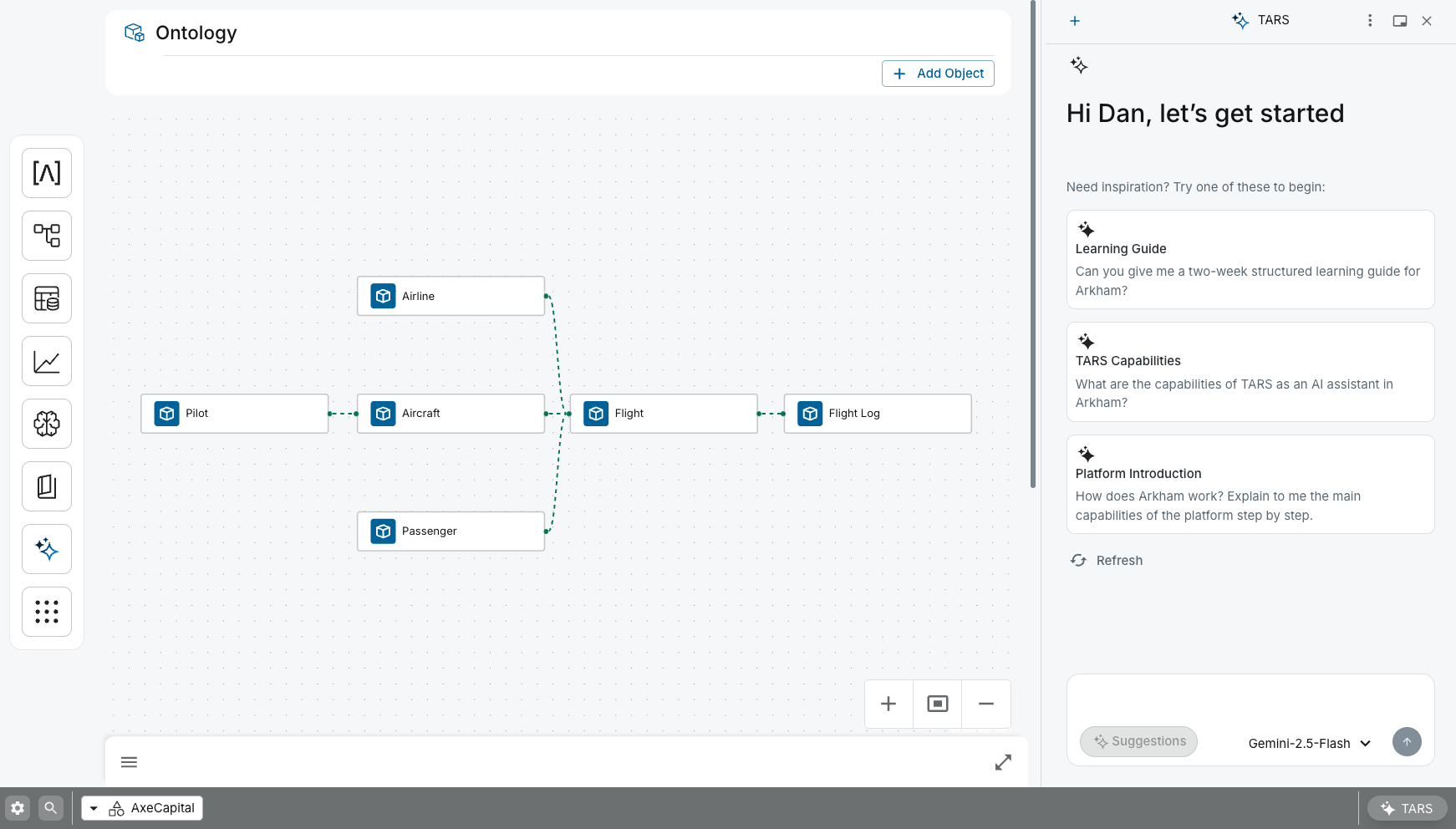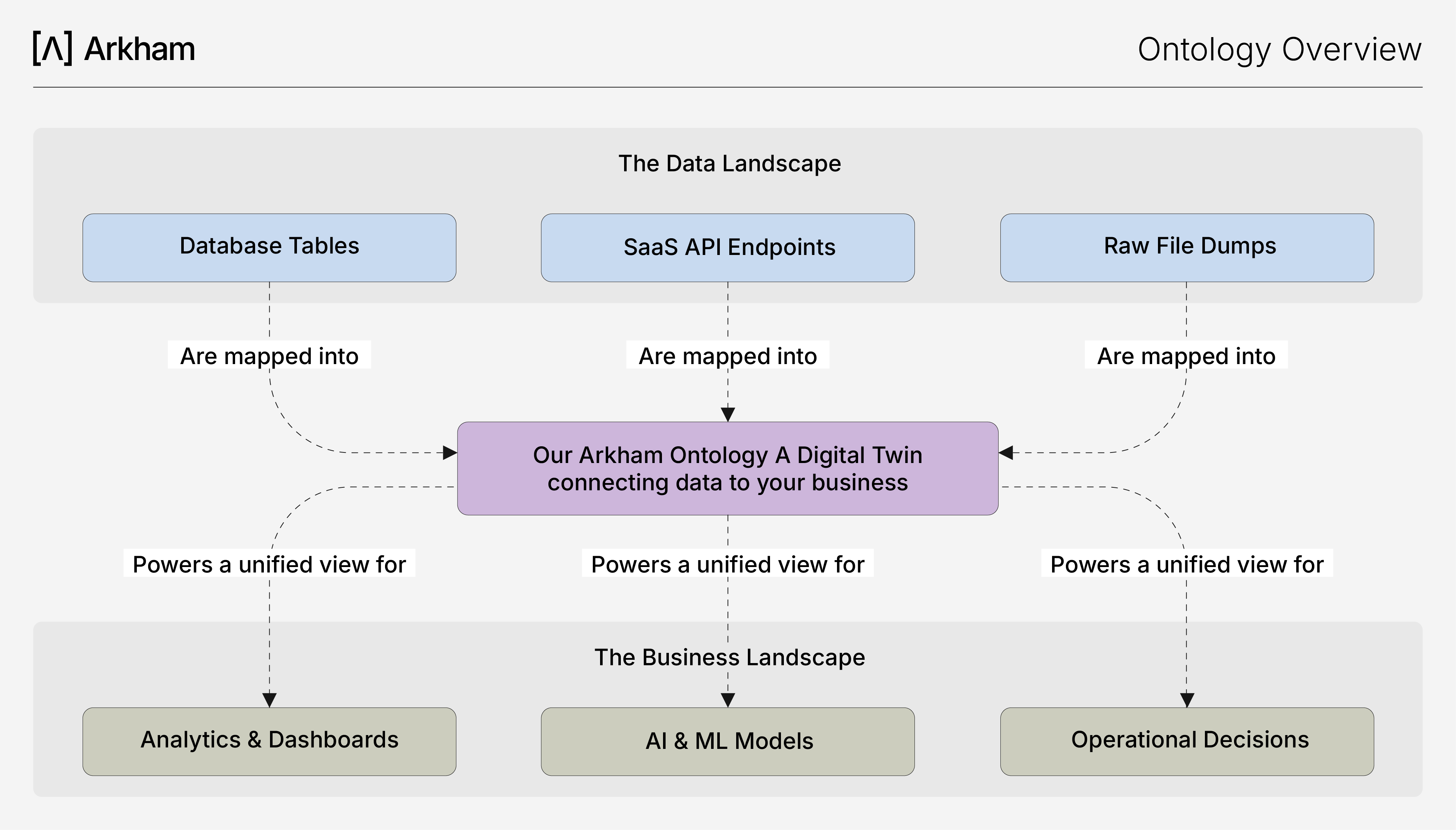Overview: Ontology
An enterprise's data is its lifeblood, but in most organizations, it flows through a maze of disconnected systems. Data teams manage databases and ETLs while operations teams speak in terms of Customers, Shipments, and Facilities. This gap between the physical reality of data and the conceptual reality of your business creates a permanent communication drag on the organization. It makes analytics slow, AI unreliable, and a shared operational picture impossible to achieve.
Arkham's Ontology is engineered to bridge this chasm. It is not merely a data model; it is our digital twin of your enterprise—a shared, living representation of your Objects, processes, and their complex Relationships. By mapping your data landscape to a clear, human-readable vocabulary, our Ontology establishes a common language for business and technical teams alike. This creates a single source of truth that radically accelerates development, ensures analytical consistency, and provides the rich semantic context required to power operational AI.
But our Ontology is more than a map. As described in our pillars below, it is an active, kinetic system. It supports not only reading data but writing it back, capturing operational decisions and user actions as a new, structured layer of insight. This transforms our Ontology from a passive model into a dynamic feedback loop, enabling your organization to learn, adapt, and automate at a scale that was previously unimaginable.

Our Ontology Builder UI, showcasing the visual graph that maps business relationships and the Details Panel providing a live preview of the underlying data for a selected Object.
Arkham's Pillars of a Digital Twin: Semantics and Kinetics
Arkham's Ontology is more than a passive data model; it's an active, operational layer. It has two key dimensions that work together to create a true digital twin of your business.

This diagram illustrates how Arkham's Ontology acts as a digital twin, translating the physical reality of disparate data sources into a unified conceptual model of the business.
- Semantics: This is our foundational map of your business. By defining Objects, Properties, and Links between them, you decouple business logic from physical data storage. This creates a stable, human-readable layer that accelerates development and provides the essential context our AI Copilot TARS.
- Kinetics: This is our active layer of our Ontology. Once our semantic model is in place, it becomes a central hub for action. From updating data registries to triggering workflows.
This dual-sided approach ensures our Ontology is not just a reference, but a dynamic tool for understanding and operating your business.
Core Component
Our Ontology is comprised of one core component that allow you to model your business. More components soon.
- Ontology Builder: Model your real-world business entities into reusable Objects.
Core Concepts
Concept
Description
Object
A real-world entity, such as a Customer, Product, or Supplier.
Property
A characteristic of an Object, sourced from a column in a dataset.
Link/Relationship
A relationship between two Objects, such as Customer places Order.
User's Workflow: Semantics to Action
Our Ontology bridges the gap between your physical data and business logic through a clear, two-step process designed for builders.
- Model Your Business (Ontology Builder): The journey begins in our Ontology Builder. Here, a data architect maps columns from trusted Production datasets to create foundational Objects like
CustomerorProductand defines the Relationships between them (e.g., "CustomerplacesOrder"). This creates the semantic layer that the rest of the platform will build upon. - Consume with Confidence (Platform-Wide): With our semantic layer in place, everyone builds from the same source of truth. A business user exploring a Workbook, a data scientist building a model in ML Hub, and our TARS AI Copilot answering your natural language question all use the same Objects, guaranteeing consistent and reliable results.
Related Capabilities
Arkham's Ontology serves as the semantic backbone for the entire Arkham platform, directly integrating with and enhancing several other key capabilities.
- Data Platform: Our Ontology consumes trusted, production-grade datasets from our Data Platform as the source for its object mappings.
- AI Platform: Our Ontology provides high-quality, semantically-rich features for models in our ML Hub and provides a semantic layer for analysis in Workbooks.
- TARS: Our Ontology gives TARS our contextual understanding of business concepts it needs to answer complex, natural-language questions accurately.



